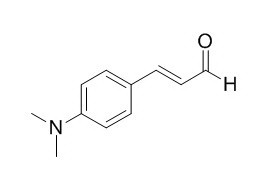4-(Dimethylamino)cinnamaldehyde
4-Dimethylaminocinnamaldehyde is a photometric reagent for primary aromatic amines. The 4-(dimethylamino)cinnamaldehyde assay is currently used to quantify proanthocyanidin (PAC) content in cranberry products.
Inquire / Order:
manager@chemfaces.com
Technical Inquiries:
service@chemfaces.com
Tel:
+86-27-84237783
Fax:
+86-27-84254680
Address:
1 Building, No. 83, CheCheng Rd., Wuhan Economic and Technological Development Zone, Wuhan, Hubei 430056, PRC
Providing storage is as stated on the product vial and the vial is kept tightly sealed, the product can be stored for up to
24 months(2-8C).
Wherever possible, you should prepare and use solutions on the same day. However, if you need to make up stock solutions in advance, we recommend that you store the solution as aliquots in tightly sealed vials at -20C. Generally, these will be useable for up to two weeks. Before use, and prior to opening the vial we recommend that you allow your product to equilibrate to room temperature for at least 1 hour.
Need more advice on solubility, usage and handling? Please email to: service@chemfaces.com
The packaging of the product may have turned upside down during transportation, resulting in the natural compounds adhering to the neck or cap of the vial. take the vial out of its packaging and gently shake to let the compounds fall to the bottom of the vial. for liquid products, centrifuge at 200-500 RPM to gather the liquid at the bottom of the vial. try to avoid loss or contamination during handling.
ARPN Journal of Eng.& Applied Sci.2016, 2199-2204
Applied Biological Chemistry2022, 65(85).
Enzyme Microb Technol.2022, 161:110111.
Herbal Formula Science2024, 32(3):203-221
VNU Journal of Science2023, 39(2):24-33.
Antioxidants (Basel).2021, 10(10):1638.
J Microbiol Biotechnol.2020, 30(2):178-186.
Hum Exp Toxicol.2017, 36(11):1169-1176
Pharmacognosy Journal.2020, 12(2), p232-235.
bioRxiv - Biochemistry2023, 548213.
Related and Featured Products
J Agric Food Chem. 2012 May 9;60(18):4578-85.
Comparison of isolated cranberry (Vaccinium macrocarpon Ait.) proanthocyanidins to catechin and procyanidins A2 and B2 for use as standards in the 4-(dimethylamino)cinnamaldehyde assay.[Pubmed:
22533362]
The 4-(Dimethylamino)cinnamaldehyde (DMAC) assay is currently used to quantify proanthocyanidin (PAC) content in cranberry products. However, this method suffers from issues of accuracy and precision in the analysis and comparison of PAC levels across a broad range of cranberry products. Current use of procyanidin A2 as a standard leads to an underestimation of PACs content in certain cranberry products, especially those containing higher molecular weight PACs.
METHODS AND RESULTS:
To begin to address the issue of accuracy, a method for the production of a cranberry PAC standard, derived from an extraction of cranberry (c-PAC) press cake, was developed and evaluated. Use of the c-PAC standard to quantify PAC content in cranberry samples resulted in values that were 2.2 times higher than those determined by procyanidin A2. Increased accuracy is critical for estimating PAC content in relationship to research on authenticity, efficacy, and bioactivity, especially in designing clinical trials for determination of putative health benefits.
J. Anal. Chem., 2004, 59(4):335-44.
4-Dimethylaminocinnamaldehyde As a Photometric Reagent for Primary Aromatic Amines[Reference:
WebLink]
The interaction of primary aromatic amines (PAAs) with 4-(Dimethylamino)cinnamaldehyde (DMACA) is studied in various media by UV, IR, and 1 H NMR spectroscopy. The optimum conditions for these reactions have been found, and the reasons for better analytical effects in the condensation reaction of PAAs with this reagent have been revealed. The physicochemical properties of the analytical form are studied using the aniline–DMACA model system as an example. A correlation has been found between the pH opt of the reactions under study and the p K a values of arylamines.
Food Chem. 2015 May 1;174:392-9.
Assessment of the stability of proanthocyanidins and other phenolic compounds in cranberry syrup after gamma-irradiation treatment and during storage.[Pubmed:
25529697 ]
Shelf life of commercial cranberry syrup irradiated with gamma radiation at a rate of 5 kGy and stored for 6 months at 25 °C and 60% relative humidity (RH) and under accelerated stability conditions was investigated.
METHODS AND RESULTS:
High-performance liquid chromatography coupled to electrospray ionisation quadrupole-time-of-flight mass spectrometry (HPLC-ESI-QTOF-MS) was used to characterise cranberry syrup. Afterwards, these compounds were quantified by HPLC-ESI-QTOF-MS and 4-(Dimethylamino)cinnamaldehyde (DMAC) assay. A significant increase in the content of procyanidin B isomer 1 (from 4.4 to 7.0 μg/ml) and procyanidin A2 (from 83 to 93 μg/ml) was observed after irradiation and compared with the non-irradiated syrup. Procyanidin B isomers and prodelphinidin were stable at 25 °C during the first month of storage, whereas quercetin and some derivatives remained constant for 3 months of storage at this temperature.
CONCLUSIONS:
In short, after gamma-irradiation in dose of 5 kGy, most compounds were highly stable for a month at 25 °C.



